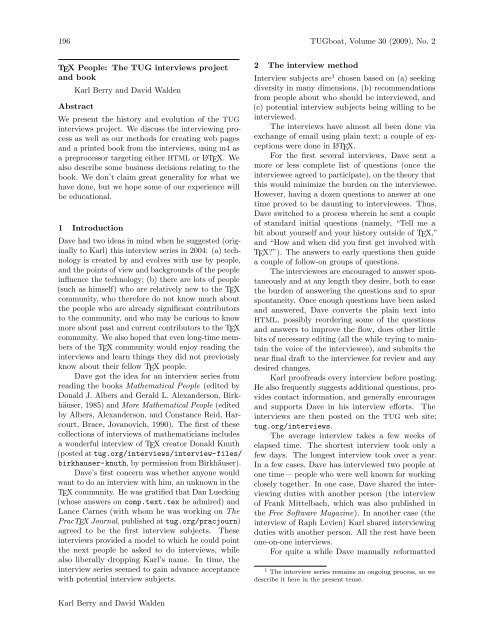The Communications of the TEX Users Group Volume 30 ... - TUG
The Communications of the TEX Users Group Volume 30 ... - TUG
The Communications of the TEX Users Group Volume 30 ... - TUG
You also want an ePaper? Increase the reach of your titles
YUMPU automatically turns print PDFs into web optimized ePapers that Google loves.
196 <strong>TUG</strong>boat, <strong>Volume</strong> <strong>30</strong> (2009), No. 2<br />
<strong>TEX</strong> People: <strong>The</strong> <strong>TUG</strong> interviews project<br />
and book<br />
Karl Berry and David Walden<br />
Abstract<br />
We present <strong>the</strong> history and evolution <strong>of</strong> <strong>the</strong> <strong>TUG</strong><br />
interviews project. We discuss <strong>the</strong> interviewing process<br />
as well as our methods for creating web pages<br />
and a printed book from <strong>the</strong> interviews, using m4 as<br />
a preprocessor targeting ei<strong>the</strong>r HTML or L A<strong>TEX</strong>. We<br />
also describe some business decisions relating to <strong>the</strong><br />
book. We don’t claim great generality for what we<br />
have done, but we hope some <strong>of</strong> our experience will<br />
be educational.<br />
1 Introduction<br />
Dave had two ideas in mind when he suggested (originally<br />
to Karl) this interview series in 2004: (a) technology<br />
is created by and evolves with use by people,<br />
and <strong>the</strong> points <strong>of</strong> view and backgrounds <strong>of</strong> <strong>the</strong> people<br />
influence <strong>the</strong> technology; (b) <strong>the</strong>re are lots <strong>of</strong> people<br />
(such as himself) who are relatively new to <strong>the</strong> <strong>TEX</strong><br />
community, who <strong>the</strong>refore do not know much about<br />
<strong>the</strong> people who are already significant contributors<br />
to <strong>the</strong> community, and who may be curious to know<br />
more about past and current contributors to <strong>the</strong> <strong>TEX</strong><br />
community. We also hoped that even long-time members<br />
<strong>of</strong> <strong>the</strong> <strong>TEX</strong> community would enjoy reading <strong>the</strong><br />
interviews and learn things <strong>the</strong>y did not previously<br />
know about <strong>the</strong>ir fellow <strong>TEX</strong> people.<br />
Dave got <strong>the</strong> idea for an interview series from<br />
reading <strong>the</strong> books Ma<strong>the</strong>matical People (edited by<br />
Donald J. Albers and Gerald L. Alexanderson, Birkhäuser,<br />
1985) and More Ma<strong>the</strong>matical People (edited<br />
by Albers, Alexanderson, and Constance Reid, Harcourt,<br />
Brace, Jovanovich, 1990). <strong>The</strong> first <strong>of</strong> <strong>the</strong>se<br />
collections <strong>of</strong> interviews <strong>of</strong> ma<strong>the</strong>maticians includes<br />
a wonderful interview <strong>of</strong> <strong>TEX</strong> creator Donald Knuth<br />
(postedattug.org/interviews/interview-files/<br />
birkhauser-knuth, by permission from Birkhäuser).<br />
Dave’s first concern was whe<strong>the</strong>r anyone would<br />
want to do an interview with him, an unknown in <strong>the</strong><br />
<strong>TEX</strong> community. He was gratified that Dan Luecking<br />
(whose answers on comp.text.tex he admired) and<br />
Lance Carnes (with whom he was working on <strong>The</strong><br />
Prac<strong>TEX</strong> Journal, published attug.org/pracjourn)<br />
agreed to be <strong>the</strong> first interview subjects. <strong>The</strong>se<br />
interviews provided a model to which he could point<br />
<strong>the</strong> next people he asked to do interviews, while<br />
also liberally dropping Karl’s name. In time, <strong>the</strong><br />
interview series seemed to gain advance acceptance<br />
with potential interview subjects.<br />
Karl Berry and David Walden<br />
2 <strong>The</strong> interview method<br />
Interview subjects are 1 chosen based on (a) seeking<br />
diversity in many dimensions, (b) recommendations<br />
from people about who should be interviewed, and<br />
(c) potential interview subjects being willing to be<br />
interviewed.<br />
<strong>The</strong> interviews have almost all been done via<br />
exchange <strong>of</strong> email using plain text; a couple <strong>of</strong> exceptions<br />
were done in L A<strong>TEX</strong>.<br />
For <strong>the</strong> first several interviews, Dave sent a<br />
more or less complete list <strong>of</strong> questions (once <strong>the</strong><br />
interviewee agreed to participate), on <strong>the</strong> <strong>the</strong>ory that<br />
this would minimize <strong>the</strong> burden on <strong>the</strong> interviewee.<br />
However, having a dozen questions to answer at one<br />
time proved to be daunting to interviewees. Thus,<br />
Dave switched to a process wherein he sent a couple<br />
<strong>of</strong> standard initial questions (namely, “Tell me a<br />
bit about yourself and your history outside <strong>of</strong> <strong>TEX</strong>,”<br />
and “How and when did you first get involved with<br />
<strong>TEX</strong>?”). <strong>The</strong> answers to early questions <strong>the</strong>n guide<br />
a couple <strong>of</strong> follow-on groups <strong>of</strong> questions.<br />
<strong>The</strong> interviewees are encouraged to answer spontaneously<br />
and at any length <strong>the</strong>y desire, both to ease<br />
<strong>the</strong> burden <strong>of</strong> answering <strong>the</strong> questions and to spur<br />
spontaneity. Once enough questions have been asked<br />
and answered, Dave converts <strong>the</strong> plain text into<br />
HTML, possibly reordering some <strong>of</strong> <strong>the</strong> questions<br />
and answers to improve <strong>the</strong> flow, does o<strong>the</strong>r little<br />
bits <strong>of</strong> necessary editing (all <strong>the</strong> while trying to maintain<br />
<strong>the</strong> voice <strong>of</strong> <strong>the</strong> interviewee), and submits <strong>the</strong><br />
near final draft to <strong>the</strong> interviewee for review and any<br />
desired changes.<br />
Karl pro<strong>of</strong>reads every interview before posting.<br />
He also frequently suggests additional questions, provides<br />
contact information, and generally encourages<br />
and supports Dave in his interview efforts. <strong>The</strong><br />
interviews are <strong>the</strong>n posted on <strong>the</strong> <strong>TUG</strong> web site:<br />
tug.org/interviews.<br />
<strong>The</strong> average interview takes a few weeks <strong>of</strong><br />
elapsed time. <strong>The</strong> shortest interview took only a<br />
few days. <strong>The</strong> longest interview took over a year.<br />
In a few cases, Dave has interviewed two people at<br />
one time—people who were well known for working<br />
closely toge<strong>the</strong>r. In one case, Dave shared <strong>the</strong> interviewing<br />
duties with ano<strong>the</strong>r person (<strong>the</strong> interview<br />
<strong>of</strong> Frank Mittelbach, which was also published in<br />
<strong>the</strong> Free S<strong>of</strong>tware Magazine). In ano<strong>the</strong>r case (<strong>the</strong><br />
interview <strong>of</strong> Raph Levien) Karl shared interviewing<br />
duties with ano<strong>the</strong>r person. All <strong>the</strong> rest have been<br />
one-on-one interviews.<br />
For quite a while Dave manually reformatted<br />
1 <strong>The</strong> interview series remains an ongoing process, so we<br />
describe it here in <strong>the</strong> present tense.

















